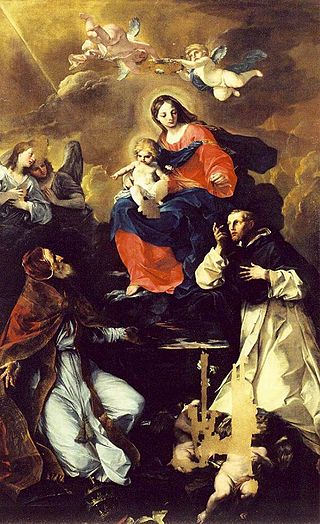
Antonio Allegri da Correggio, usually known as just Correggio was an Italian Renaissance painter who was the foremost painter of the Parma school of the High Renaissance, who was responsible for some of the most vigorous and sensuous works of the sixteenth century. In his use of dynamic composition, illusionistic perspective and dramatic foreshortening, Correggio prefigured the Baroque art of the seventeenth century and the Rococo art of the eighteenth century. He is considered a master of chiaroscuro.

Bernardo Strozzi, named il Cappuccino and il Prete Genovese, was an Italian Baroque painter and engraver. A canvas and fresco artist, his wide subject range included history, allegorical, genre and portrait paintings as well as still lifes. Born and initially mainly active in Genoa, he worked in Venice in the latter part of his career. His work exercised considerable influence on artistic developments in both cities. He is considered a principal founder of the Venetian Baroque style. His powerful art stands out by its rich and glowing colour and broad, energetic brushstrokes.

Giuseppe Maria Crespi, nicknamed Lo Spagnuolo, was an Italian late Baroque painter of the Bolognese School. His eclectic output includes religious paintings and portraits, but he is now most famous for his genre paintings.

Giovanni Benedetto Castiglione was an Italian Baroque painter, printmaker and draftsman, of the Genoese school. He is best known now for his etchings, and as the inventor of the printmaking technique of monotyping. He was known as Il Grechetto in Italy and in France as Le Benédette.

Pordenone, Il Pordenone in Italian, is the byname of Giovanni Antonio de’ Sacchis, an Italian Mannerist painter, loosely of the Venetian school. Vasari, his main biographer, wrongly identifies him as Giovanni Antonio Licinio. He painted in several cities in northern Italy "with speed, vigor, and deliberate coarseness of expression and execution—intended to shock".
Bernardo Castello (1557–1629) was an Italian painter of the late-Mannerist style, active mainly in Genoa and Liguria. He is mainly known as a portrait and historical painter.
Events from the year 1600 in art.

Francesco Trevisani was an Italian painter, active in the period called either early Rococo or late Baroque (barochetto).

Domenico Fiasella was an Italian painter of the Baroque period, mainly active in Genoa. He was nicknamed Il Sarzana, after his birthplace.

Felice Torelli was an Italian painter of the Baroque style, active mainly in Bologna.

Giovanni Bernardino Azzolini was an Italian painter and sculptor who continued painting in a late-Mannerist style, mainly active in Naples and Genoa. He is also known by Azzolino or Mazzolini or Asoleni.

Clemente Bocciardo (1620–1658) was an Italian painter of the Baroque. He was born in Genoa. He was also called Clementone because of his large size. He was a pupil of Bernardo Strozzi and accompanied Giovanni Benedetto Castiglione to Rome. He painted a Martyrdom of St. Sebastian for the church of the Carthusians in Pisa. He also painted in Florence.
Domenico Bocciardo was an Italian painter of the Baroque period, active in Genoa.Native of Finale Ligure, but died in Genoa. He was a pupil of Giovanni Maria Morandi in Rome, but upon the death of Morandi in 1717, went to Genoa to work. He painted a San Giovanni baptizing the Multitude for the church of San Paolo in Genoa.

Pietro Bianchi was an Italian painter of the Baroque and early Rococo periods, active in Genoa and Rome. While his work is noted for its quality and beauty, his perfectionism and constant reworking of his paintings meant that his extant output is sparse.

Giovanni Maria delle Piane was an aristocratic Genovese who served as primary court painter for over 60 years in the late-Baroque period. He is also known as "il Molinaretto".

Anton Maria Maragliano was an Italian sculptor of the Baroque period, known primarily for his wooden statues. He was born in Genoa, where he led an important workshop.

Antonio de Pereda y Salgado was a Spanish Baroque-era painter, best known for his still lifes.

The Abbey of Santa Giustina is a 10th-century Benedictine abbey complex located in front of the Prato della Valle in central Padua, region of Veneto, Italy. Adjacent to the former monastery is the basilica church of Santa Giustina, initially built in the 6th century, but whose present form derives from a 17th-century reconstruction.
Francesco Nasini was an Italian painter of the Baroque period, active mainly in towns outside of Siena, Italy.

Jan Roos, was a Flemish artist who, after training in Antwerp, mainly worked in Italy where he was called Giovanni Rosa. He was known for his still life paintings of flowers and vegetables, mythological and religious scenes and portraits. His style of still life painting had an important influence on the art of the local painters of the Genoese school.

















